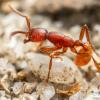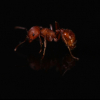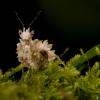- Formiculture.com
- Forums
- Gallery
- Members
- Member Map
- Chat

Neivamyrmex nigrescens
Started By
PurdueEntomology
, Aug 2 2018 1:09 AM
84 replies to this topic
#21
 Offline
-
Posted August 5 2018 - 12:03 PM
Offline
-
Posted August 5 2018 - 12:03 PM
That's really cool! Keep the picture's coming.
#22
 Offline
-
Posted August 7 2018 - 12:25 PM
Offline
-
Posted August 7 2018 - 12:25 PM
Today: Begin constructing a set of interconnected 'outworlds' as I prepare for the eggs to hatch and the colony to begin a nomadic phase. A typical formicarium with a specific location for the queen and brood is not relevant with this species, hence a design that will allow for movement and bivouacing. The current pupae are darkening indicating that they are closer to eclosion. The eggs have been moved so are not observable. The colony has readily accepted S. invicta larvae and pupae, crickets and mealworms as food.
#23
 Offline
-
Posted August 9 2018 - 2:47 PM
Offline
-
Posted August 9 2018 - 2:47 PM
Update: Many pupae are turning amber and seem to be near to eclosion. Eggs were seen yesterday and were fine, today they have been moved into a location where they cannot be seen. From a research article "ONSET OF THE NOMADIC PHASE IN THE ARMY ANT NEIVAMYRMEX NIGRESCENS (CRESSON) (HYM. FORM.): DISTINGUISHING BETWEEN CALLOW AND LARVAL EXCITATION BY BROOD SUBSTITUTION " the eggs hatch after approximately 15 days after being laid, I expect that they should be hatching in about 8 days at that time callows should have appeared and eclosion of remaining pupae underway. This will initiate a nomadic phase which will change the dynamics of their being housed. I have created a set of outworlds and have yet figured out how to transfer the colony to the outworlds habitat.
#24
 Offline
-
Posted August 9 2018 - 2:58 PM
Offline
-
Posted August 9 2018 - 2:58 PM
Very interesting observations. Although as all here know I am not keen on the idea of keeping Neivamyrmex and other army ants I do have some hope that you succeed.
- nurbs, TennesseeAnts and PurdueEntomology like this
#25
 Offline
-
Posted August 9 2018 - 4:41 PM
Offline
-
Posted August 9 2018 - 4:41 PM
This is interesting, I have a couple thoughts:
Firstly, do you have any ideas about perhaps raising a colony of ants specifically so that their brood can be harvested? That way, you wouldn't have to rely upon external sources.
Secondly, is there any chance you'd be able to get some macro shots of some of the ants? I'm interested to really see what they look like up close.
Finally, for your extended setup, if you're connecting the outworlds with tubes, you could coil up the tube so that the ants have to travel longer distances to get to their next outworld, better simulating the natural world.
I'm curious to see where this goes.
- PurdueEntomology likes this
#26
 Offline
-
Posted August 10 2018 - 12:46 AM
Offline
-
Posted August 10 2018 - 12:46 AM
Nare: Yes I have thought about that as an option since most of the academic works I have consumed lately involving this species their having traveled or made to travel [as per those where live colonies were housed for research purposes] distances of up to 15 meters were established in controlled environments; the upshot, I think a coiled tubing would be a great idea that gives them distance and yet conserve space, my only issue I have is the question is this, since this is primarily a subterranean species would it (a) move vertically up a coil or along a coil and (![]() would it need a substrate in the coil or would the soil without substrate [ better simulating natural environment] be sufficient? I also wonder if the plastic smell of the
would it need a substrate in the coil or would the soil without substrate [ better simulating natural environment] be sufficient? I also wonder if the plastic smell of the
GCSnelling: Thank you for your contribution, firstly. Secondly, thank you for your professional/academic research. I truly appreciate your reservations on housing this species, but with that said, I also hope I succeed too. I have been making many observations and logging them outside these forum updates as I daily observe the colony. I have learned much about them I did not know.
As I have remarked, if I see the colony under stress I will release them. So far though I have not, there have been no die off of any ants, actually I have not seen one dead ant so far, and secondly they are actively eating both the larvae/pupae and crickets I have been giving them, they now drag the crickets into the nest area, before that was not observed. I have noted that they keep the food brood separate from the their pupae, though I have observed a few food pupae or larvae in their pupae but only sporadically, so it seems they definitely keep the two separate.
- Nare likes this
#27
 Offline
-
Posted August 10 2018 - 12:58 AM
Offline
-
Posted August 10 2018 - 12:58 AM
I will do my best on the macro shots fyi.
#28
 Offline
-
Posted August 13 2018 - 4:50 PM
Offline
-
Posted August 13 2018 - 4:50 PM
Attempting to bait them into a new container.
#30
 Offline
-
Posted August 15 2018 - 3:34 PM
Offline
-
Posted August 15 2018 - 3:34 PM
Sure if i catch it.
#31
 Offline
-
Posted August 17 2018 - 11:37 AM
Offline
-
Posted August 17 2018 - 11:37 AM
Colony is doing well, despite some negative expectations. The current batch of pupae have almost all eclosed, thus shooting up the colony population. The status of last weeks eggs is still unknown, save they were seen in a mass of ants two days ago still unhatched. The eggs were first observed 12 days ago.
- gcsnelling likes this
#32
 Offline
-
Posted August 18 2018 - 12:27 AM
Offline
-
Posted August 18 2018 - 12:27 AM
Two outworlds have been connected with a 5/8" clear tube 13" in length. The first originally received the colony, the second attached on 8/13/18. The second originally only had a Turfex/Pumice 1/8" max diameter particle size mix. Pieces of length wise folded cardboard was added to create roofed spaces, yet recently a fourth flat piece of cardboard was placed on top of the peaks of the roofed pieces then a 1/8-3/8" layer of 1/8" max diameter sifted soil was layered over the cardboard pieces and misted to moisten it, the idea was to overall create a more humid/moist environment as the Turfex/Pumice dried too quickly and did not allow for successful wall building by the ants. The colony currently has three groups of mixed older and callow ants: 1st in original container, 2nd in tube [eggs in this group], 3rd in newer outworld; each group has food-brood dispersed in them. The 2nd group can easily be observed feeding on food-brood. Humidity and moisture requirements are unknown as nothing has been cited in any available literature on the species, but with the current housing and pupal eclosure and development conditions must be assumed to be adequate for their well being. Temperature is a constant 77-78F. A 20 day developmental period for egg maturation and appearance of first instar larvae is assumed. As has been noted no unusual behavior indicating a migratory move by the colony has been observed. The colony is being well stocked with brood-food. Status of gyne is unknown as she has not been observed, she is assumed to be in the 2nd group in the tube with the eggs encircled by workers obscuring any confirmation of her presence.
Edited by PurdueEntomology, August 18 2018 - 5:45 AM.
#33
 Offline
-
Posted August 18 2018 - 3:30 AM
Offline
-
Posted August 18 2018 - 3:30 AM
Queen Update: She was observed moving into the 2nd container. She was stenogastric.
Edited by PurdueEntomology, August 18 2018 - 5:45 AM.
- AnthonyP163 likes this
#34
 Offline
-
Posted August 19 2018 - 4:08 AM
Offline
-
Posted August 19 2018 - 4:08 AM
Update: Successfully had colony move to new container as previously described. The old container was disconnected, cleaned using light bleach solution and soap, thoroughly rinsed, dried with new substrate added and reattached. The connecting tube was not removed and cleaned due to presence of ants. The current container housing the colony keeps them well hidden so observation is not as it was before. All the pupae have eclosed and the callow ants are quickly taking on a darker color. There have been no indicators of nomadic activity though the last time the eggs were observed they had not hatched. A second smaller out world may be attached to give them more wandering space but so far it does not seem necessary.
- CatsnAnts likes this
#35
 Offline
-
Posted August 19 2018 - 2:59 PM
Offline
-
Posted August 19 2018 - 2:59 PM
Two more out worlds were connected today. There are a total of 4 outworlds interconnected housing the colony now.
- Leo and TennesseeAnts like this
#36
 Offline
-
Posted August 24 2018 - 1:18 AM
Offline
-
Posted August 24 2018 - 1:18 AM
Current Setup: At end when I remove the cover over tube you can just see queen moving from the right to the left.
Edited by PurdueEntomology, August 24 2018 - 1:21 AM.
- AntsBC likes this
#37
 Offline
-
Posted August 27 2018 - 2:20 PM
Offline
-
Posted August 27 2018 - 2:20 PM
This is absolutely stunning. Amazing work you've done! That brood pile is amazing! Definitely following this!
- PurdueEntomology likes this
Proverbs 6:6-8 New International Version (NIV)
6 Go to the ant, you sluggard;
consider its ways and be wise!
7 It has no commander,
no overseer or ruler,
8 yet it stores its provisions in summer
and gathers its food at harvest.
#39
 Offline
-
Posted August 28 2018 - 2:52 AM
Offline
-
Posted August 28 2018 - 2:52 AM
I think one of the keys is that you have been able to feed them brood. More updates!
#40
 Offline
-
Posted August 28 2018 - 3:05 AM
Offline
-
Posted August 28 2018 - 3:05 AM
Yes, I think that supplying them a brood as food is the fundamental in keeping this species, and perhaps its sister species. This is also most likely the drawback in attempting to keep this species, if one does not have a steady and readily available brood-food supply with the quantities demanded by a colony to feed not only the adults but larvae then no attempt should be made to keep them. As for some concerns about their nomadic nature, to date that has not been an issue at all. I am going to try to get all the colony into the one container where their brood is so I can at least exam the status of their brood. I will attempt that today.
- gcsnelling and LC3 like this
0 user(s) are reading this topic
0 members, 0 guests, 0 anonymous users
















